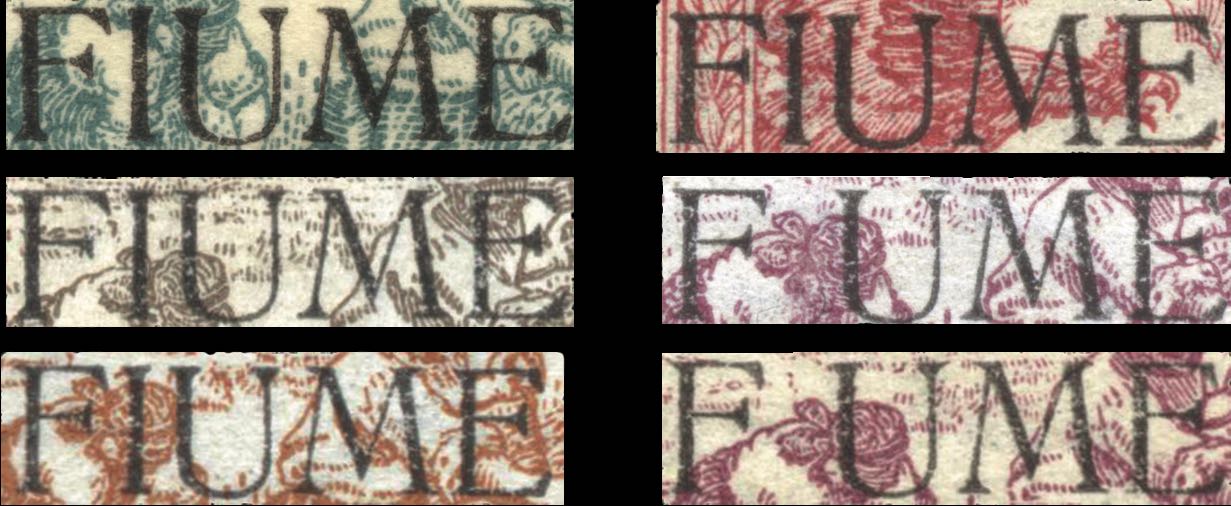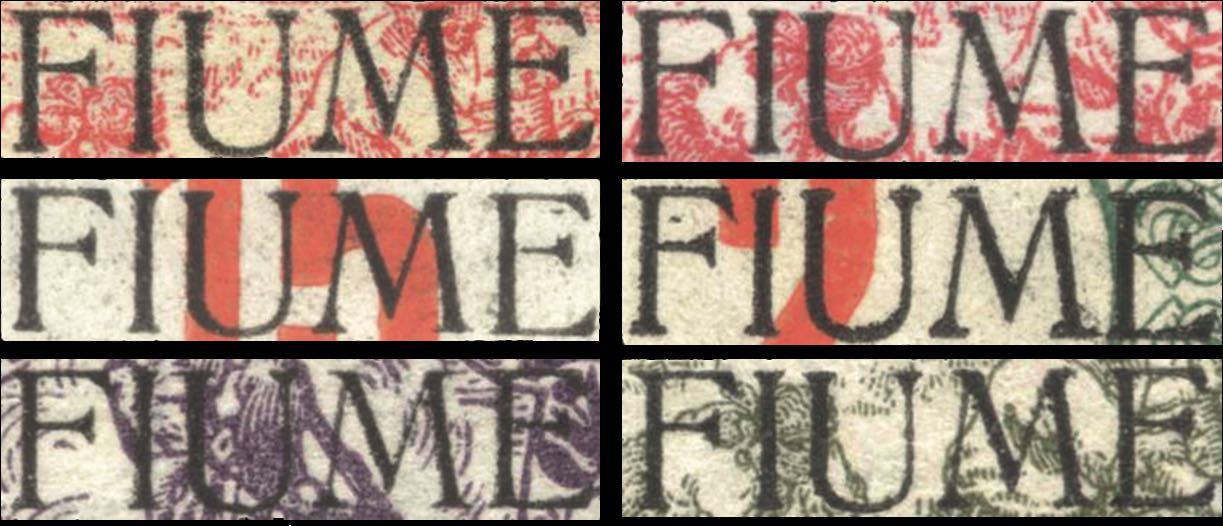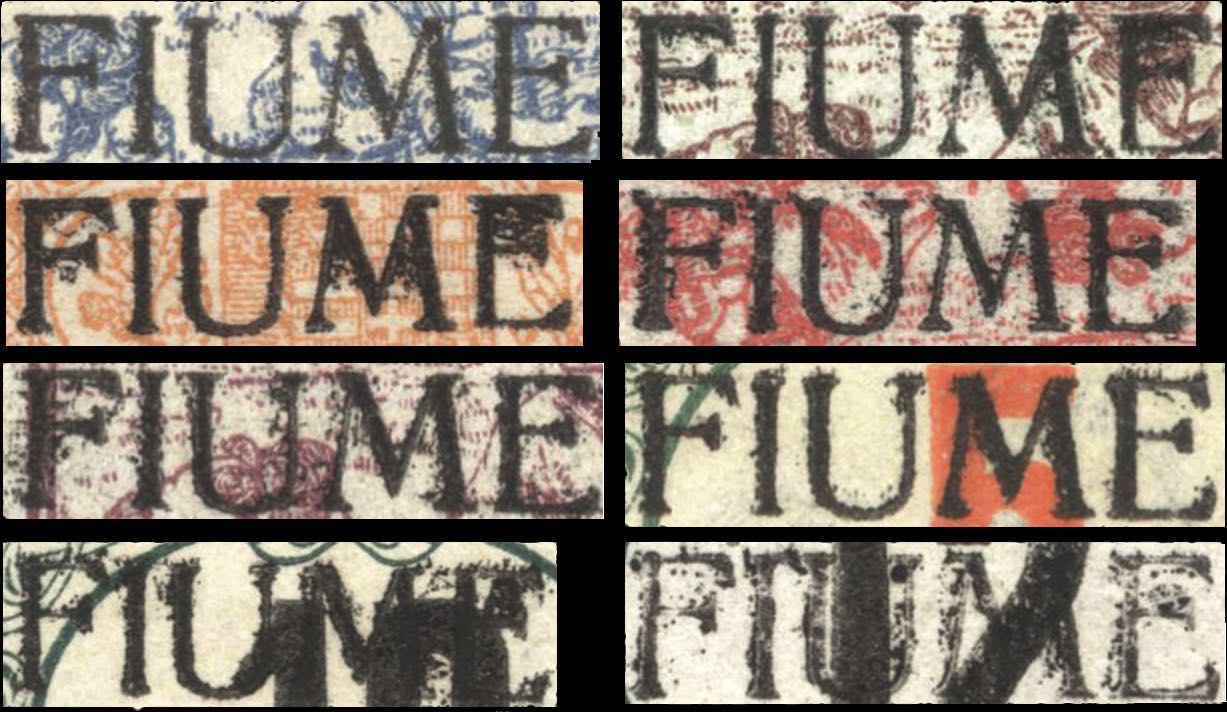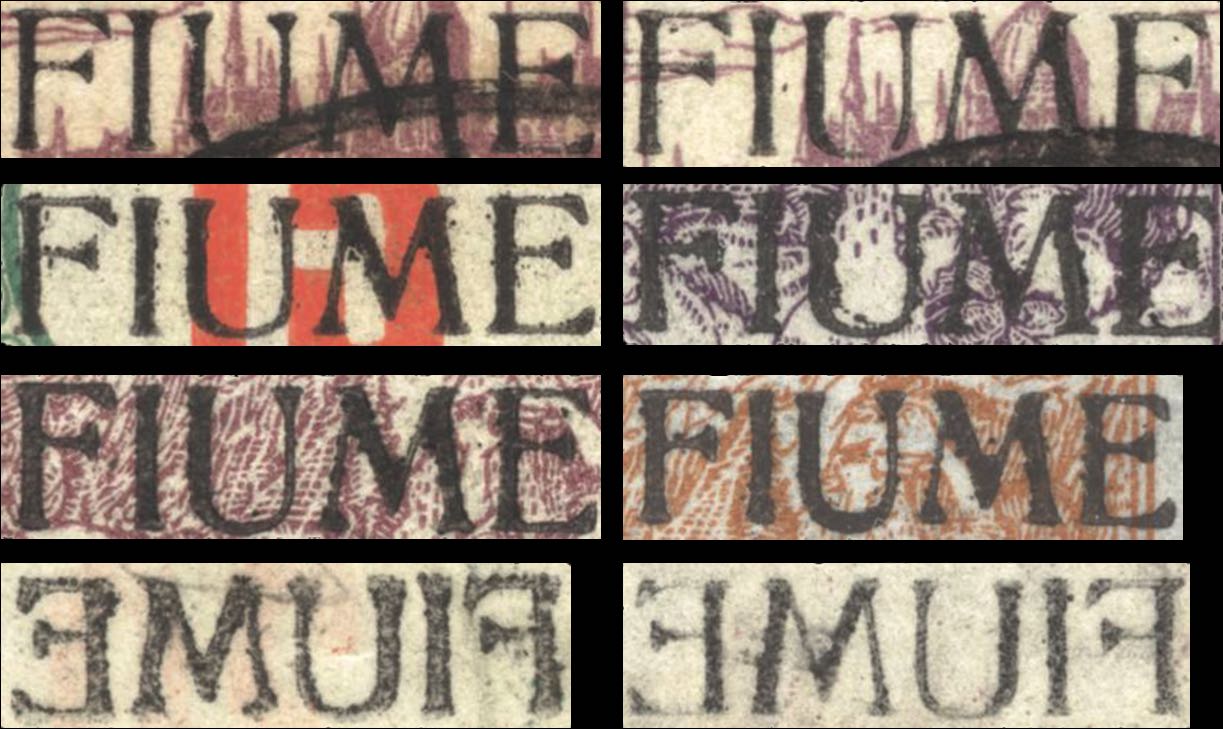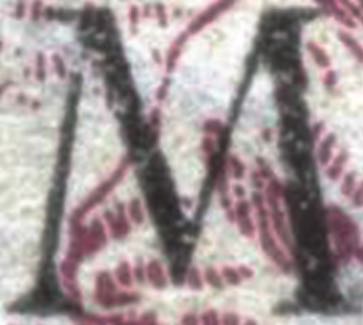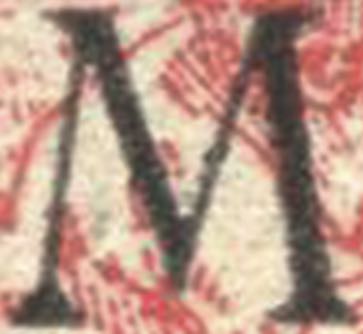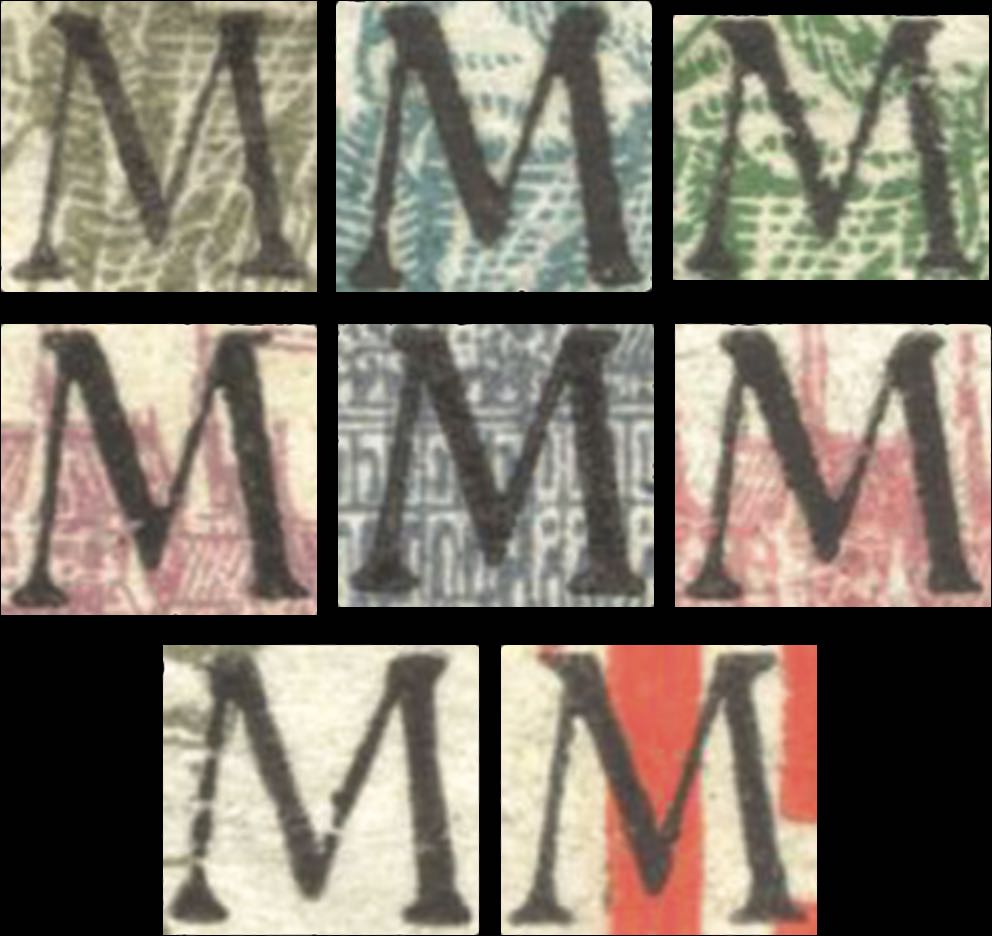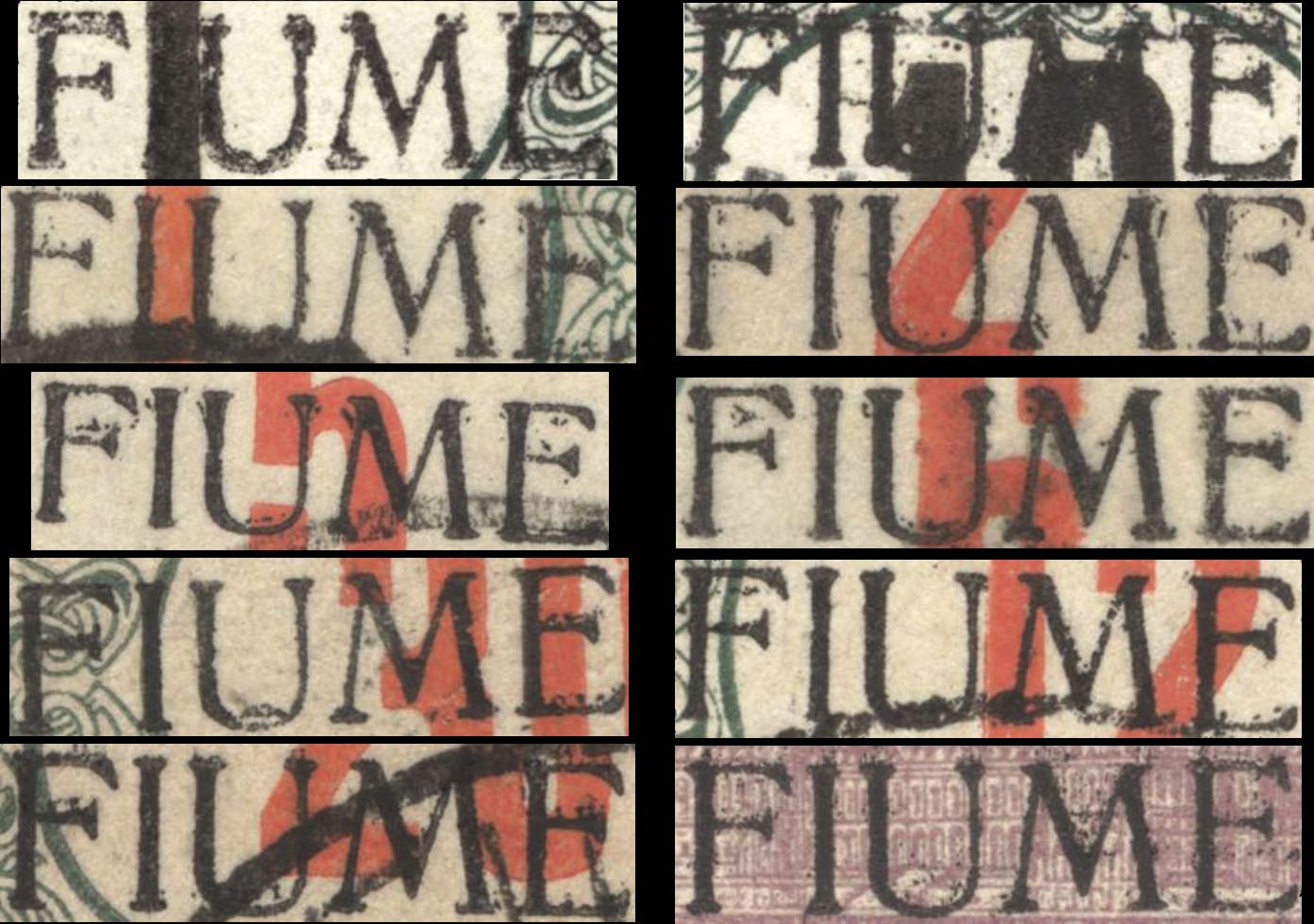by Nenad Rogina and Ivan Martinâs originally published in FIL-ITALIA Volume XLII, no. 1 Winter 2016.
Why have the FIUME overprints on Hungarian stamps created so much confusion? The answer can be found in the following facts:
- – A very simple font and design of the overprint that was apparently easy to forge.
- – Stamps were overprinted unanticipatedly, without predetermined printing run for a specific value over a period of only three weeks.
- – The printing run was insufficient to meet the needs of postal demand and, given the unresolved “Fiume question”, collectors from around the world wanted to acquire their own copy of each stamp. At the time “War Stamps” were extremely popular.
- – Individuals could bring the old regime Hungarian stamps from home to be hand-overprinted so that they could be postally used under the new administration.
- – Some denominations were hand-overprinted in a very small number of copies and are therefore rare; the demand for such stamps was high and the supply almost non existent, which is why overprints and stamps were forged, sometimes in large quantities.
For these reasons forgers began to forge overprints at an early stage, as a result the first forgeries occurred while the genuine stamps were still on sale at post offices in Fiume. All denominations were used by the forgers to create their forgeries, even on stamps that at the time were not available for sale at the post offices in Fiume. A large quantity of overprinted stamps were fabricated by the forgers, most of these forgeries were overprinted by letterpress, whence their commonly used name of machine overprinted stamps.
Complete sheets that could, according to the accounts from that time, easily be purchased from the not so distant Hungary at very low prices, since the Hungarian crown was being eaten away by in ation, were utilised.
It is more likely that the un-overprinted Hungarian stamps were obtained at the neighboring city of Sušak (now part of the city of Rijeka). At that time, Susak belonged to the newly formed State of Slovenes, Croats and Serbs, where the Hungarian stamps had postal use. The practice of forging FIUME overprints utilizing original Hungarian stamps continued for quite some time.
We have not seen examples where both the stamp and the overprint are forged. It is obvious that the business of forgery proved lucrative, because forgers continued to make forgeries of all subsequent Fiume issues, and this continued all the way up to the new millennium.
For the purposes of this article we shall not deal with the measurements and basic characteristics of machine and hand overprints that have already been described in detail in the existing literature many times. Our goal is to present and describe the types of genuine overprints side-by-side with corresponding forgeries, providing clues to identification of genuine and forged overprints.
Forgeries presented in this article are certainly not all that can be found on the market today because their number is so high that they probably would not fit into a whole issue of this magazine. Therefore, we have shown only the forged overprints that we think are more problematic for the average collector to identify.
We think that the images of overprints need to be presented in a sufficiently large size to make it easier to spot colors and differences among overprints, which during the analysis of overprints, on actual stamps, is quite demanding since these overprints are just above one centimeter in length. We deliberately do not want to use strictly defined dimensions that can be found in literature, because the height and length of overprints may vary depending on a number of factors, and this especially applies to hand overprints.
FIUME Overprint, Provisional Hand Stamped
On the 2 December 1918, at the printing workshop of Adolf Kirchofer & Co. a test hand overprint “FIUME” was used on three sheets (100 stamps each) of the 20 filler value of the 1916 Hungary definitive Harvesters series. A rubber hand-stamp was used for overprinting. The overprint was thick and and the ink black, decidedly more black than the later issued hand overprints. The provisional overprint was later rejected, nevertheless part of the stamps ended up on sale at the post offices, making this first Fiume stamp extremely interesting for collectors. Because of the rarity, there are forgeries of this overprint, but the forgers were not able to make imitations that were treacherously similar to the genuine overprint, as a result the forgeries of this overprint are easily recognizable as shown on the examples below.
FIUME Overprint, Machine Type
Since a large amount of stamps had to be overprinted for the needs of the postal service in a very short period of time, the Adolf Kirchofer & Co. printing workshop was unable to meet the demand and the job was farmed out to the Fiume-based Urania printing workshop, owned by Wadasz and Caravanich, where stamps were machine (letterpress) overprinted. According to the instructions from Kirchofer, the Urania printing workshop had prepared two plates for machine overprint of the needed stamps. One for smaller stamps of lower denominations of the Harvesters series and one for larger high denominations from the Parliament series. This form of overprint consisting of typographic fonts, which was officially adopted, was much thinner than the previously shown and all letters were serifed – test one. Each plate was set to overprint a sheet of 100 stamps in a single operation. Part sheets of certain face values were held together with adhesive tape so that they could be overprinted by machine (letterpress). The stamps were machine overprinted for three days. The first two days (3 and 4 December 1918) they were overprinted with the Type 1 machine overprint, and the last day (5 December 1918) with the Type 2 of machine overprint. The main differences between these two types of letterpress overprints is the ink that was used, and the light to somewhat pronounced fuzz on parts of the Type 2 overprint impressions.
FIUME Overprint, Machine Type 1
Genuine
First type of machine overprint was carried out with two new, clean plates and high-quality ink. The color of the overprint is gray-black, crisp and dry, and the serifs of the letters very thin and straight.
A different ink was used for the second type of machine overprint, more black than gray. Some authors suggest that a more black ink was used to highlight “FIUME”, but this theory is unlikely. The war ink of inferior quality was the ink actually used. With usage the plates accumulated dirt, therefore the overprint is somewhat thicker than overprints of the rst issue. Overprints can range from ne ones with crisp and clearly de ned serifs to ones affected by fuzz generated by untidy plates. Depending on the time of production overprints may be thicker or thinner, and the serifs of “FIUME” letters can be sharp (like those printed earlier), or somewhat rounder for later produced overprints. Offset overprints are common, especially in later overprinted stamps like the so called “Tiratura Successiva“, which was well described by Oliviero Emoroso in his book.
FIUME Overprint, Machine Type 2
Genuine
Overprint impressions are affected by light to somewhat pronounced fuzz not altering the shape and serifs of letters
Type 2 Second printing – overprint is slightly thicker, the serifs tend to be rounded and less sharp. It is common to see an offset of the overprint on the gummed side.
Determining Authenticity of Machine Overprints
The first step to take when examining machine overprints is to own genuine examples of different types of machine overprints (1 and 2) for comparison. Minor differences between overprints are best visible when comparing complete sheets. As stamps from “Harvesters” series were overprinted with one plate, and stamps from “Parliament” series with the other plate, it is best to obtain overprinted sheets of both series (face values of stamps are not important). For the sample of the rst type of machine overprint it would be best to obtain the sheet with F UME variety because this error exists only in rst type of machine overprint. You should be careful because there are completely forged sheets with F UME error. For the sample of second type of machine overprint you could use postage due stamp overprints as they are easy to obtain as a complete sheet. Since postage due stamps were overprinted on the last day using a new plate made of the parts of the rst two plates, they are overprinted only with the second type of machine overprint and they don’t exist with rst type overprints. Postage due overprints are often dirty because of the unclean printing plate. In machine overprint, serifs of the letters are thin, straight and crisp, especially in the rst type of machine overprint. In second type of machine overprint serifs are slightly thicker and the ink is a little more black, in rare cases dark black. Parts of the letter endings of the second type of the machine overprint may be blurry, as if they were printed with chalk on uneven surface. This characteristic should not be confused with the “fuzziness” of the impressions of the second type of machine overprint.
The letter “M” of most forged overprints differs from the original. After a short time of concentration on the tiny details the eye is trained to recognize with great accuracy the angle at the top of the diagonal lines of the letter “M”. By careful examination of the letter “M” we will be able to dismiss many, less successful, forgeries. The middle two diagonal lines of the letter M are straight and are perfectly connected at the top and form a very pointed end at the bottom.
Genuine Type 1
- – Well defined serifs
- – Diagonal strokes join seamlessly with the serifs at the top
- – Watch both feet of the letter “M”
Genuine Type 2
- – Watch the thickness of the diagonal stroke at left, as diagonal strokes join, they form a very sharp end
In the beginning of the detection process our focus must be on the thickness of the lines, stems, and strokes of the letters; the same attention must be paid to the serifs and the letters’ outline. Genuine overprints can be identi ed if we carefully examine each letter individually. The arm of the letter F ends at right with a serif slanted forward, it differs from the serif at the right end of the arm of the letter E, which also ends with a forward slant. The arms of the letter U are straight: the right arm, or more accurately the hairline, is duly thinner than its left counterpart. The diagonal strokes of the letter M are seamlessly joined to the top serifs.
Genuine overprint: arrows indicate critical details useful to assess the authenticity of overprints.
FIUME Overprint, Machine Type 1
Forgeries
Ink is gray-black, overprint is quite similar to a genuine Type 1 which was not used for overprinting 10 filler (Harvesters series) stamps.
Ink is a dry gray color. The letters are slender, similar to the machine overprint Type 1, which was not used for overprinting postage due stamps.
FIUME Overprint, Machine Type 2
Forgeries
Ink has an oily apperance, letters are thinner than in the genuine overprint on 10 filler (Harvesters) stamps, possible cracks in letters.
Ink is gray-black, the serifs have a blunt end. This forgery is confused with the genuine hand overprint Type II.
On the postage due stamps with fuzz affecting parts of the letters. Jet-black, thick ink. Behind the fuzz there are no sharp serifs like in genuine machine overprint.
FIUME Overprint, Machine Type
Easy Recognisable Forgeries



